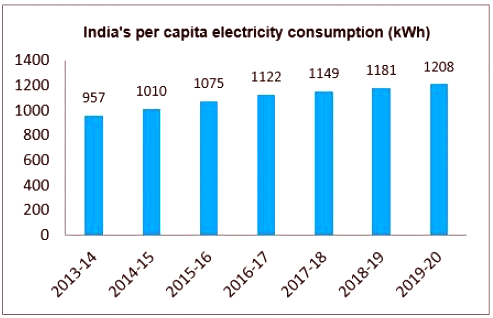Roadmap for India’s Offshore Wind Energy | 21 Jul 2021
Why in News
Recently, the Ministry of New and Renewable Energy (MNRE) has set a target of installing 5 GW of offshore capacity by 2022 and 30 GW by 2030.
- India can generate 127 GW of offshore wind energy with its 7,600 km of coastline.
Key Points
- About Offshore Wind Energy:
- Wind energy today typically comes in two different “types”: onshore wind farms which are large installations of wind turbines located on land, and offshore wind farms which are installations located in bodies of water.
- Offshore wind energy refers to the deployment of wind farms inside the water bodies. They utilise the sea winds to generate electricity. These wind farms either use fixed-foundation turbines or floating wind turbines.
- A fixed-foundation turbine is built in shallow water, whereas a floating wind turbine is built in deeper waters where its foundation is anchored in the seabed. Floating wind farms are still in their infancy.
- Offshore wind farms must be at least 200 nautical miles from the shore and 50 feet deep in the ocean.
- Offshore wind turbines produce electricity which is returned to shore through cables buried in the ocean floor.
- Status of Wind Energy in India:
- India’s electricity generation from wind reached 39.2 gigawatts (GW) a year in March 2021. An addition of another 20 GW over the next five years is expected to happen soon.
- The compound annual growth rate for wind generation has been 11.39% between 2010 and 2020, and for installed capacity, it has been 8.78%.
- More than 95% of commercially exploitable resources are located in seven states: Andhra Pradesh, Gujarat, Karnataka, Madhya Pradesh, Maharashtra, Rajasthan and Tamil Nadu.
- Benefits:
- Wind speed over water bodies is high and is consistent in direction. As a result, offshore wind farms generate more electricity per installed capacity.
- Fewer offshore turbines are required to produce the same capacity of energy as compared to onshore ones.
- Offshore wind farms have a higher CUF (capacity utilisation factor) than onshore wind farms. Therefore, offshore wind power allows for longer operating hours.
- A wind turbine's CUF is equal to the average output power divided by the maximum power capabilities.
- It's possible to build bigger and taller offshore windmills, resulting in increased energy harvest.
- Furthermore, the wind flow is not restricted by hills or buildings.
- Challenges:
- Higher Installation Cost:
- Local substructure manufacturers, installations vessels and trained workers are lacking in India. Offshore wind turbines require stronger structures and foundations than onshore wind farms. This can cause higher installation costs.
- Higher Maintenance Cost:
- The action of waves and even high winds, particularly during storms or hurricanes, can damage wind turbines. Eventually, offshore wind farms require maintenance that is more costly and difficult to perform.
- Higher Installation Cost:
- Policies related to Wind Energy:
- National Wind-Solar Hybrid Policy: The main objective of the National Wind-Solar Hybrid Policy, 2018 is to provide a framework for promotion of large grid connected wind-solar PV hybrid systems for optimal and efficient utilization of wind and solar resources, transmission infrastructure and land.
- National Offshore Wind Energy Policy: The National Offshore wind energy policy was notified in October 2015 with an objective to develop the offshore wind energy in the Indian Exclusive Economic Zone (EEZ) along the Indian coastline of 7600 km.
Way Forward
- Renewable purchase obligation: Power distribution companies, open access consumers and captive users can purchase clean energy as part of their total electricity consumption through a renewable purchase obligation.
- Lower taxes: In India, the GST Law exempts electricity and power sales from GST. In contrast, wind power generation companies cannot claim input tax credits when they pay GST to purchase goods and/or services for setting up the project.
- Feed-in tariff: Discoms can adopt feed-in tariff (FiT) regulations and make offshore wind power procurement mandatory. FiT can be tailored to suit each offshore wind project. FiT can be used to promote offshore wind power in the early stages of development until it becomes economically viable.
- Deemed generation provision: Offshore wind projects need to be protected against curtailment concerns because of the inability of State Load Dispatch Centres (SLDCs) to absorb large quantities of power that may be generated. For this, the offshore wind can be given a “deemed generation provision”.

